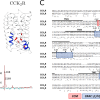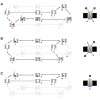
Evidence that specific interactions play a role in the cholesterol sensitivity of G protein-coupled receptors
G protein-coupled receptors (GPCRs) make up the largest family of proteins in mammalian cells. These receptors are known to be sensitive to cholesterol in the cellular membrane. Coarse-grained molecular dynamics (CGMD) was used to identify specific protein-cholesterol interaction sites. The analysis showed differential cholesterol binding on equivalent residues in homologues known to have different sensitivities to cholesterol.




